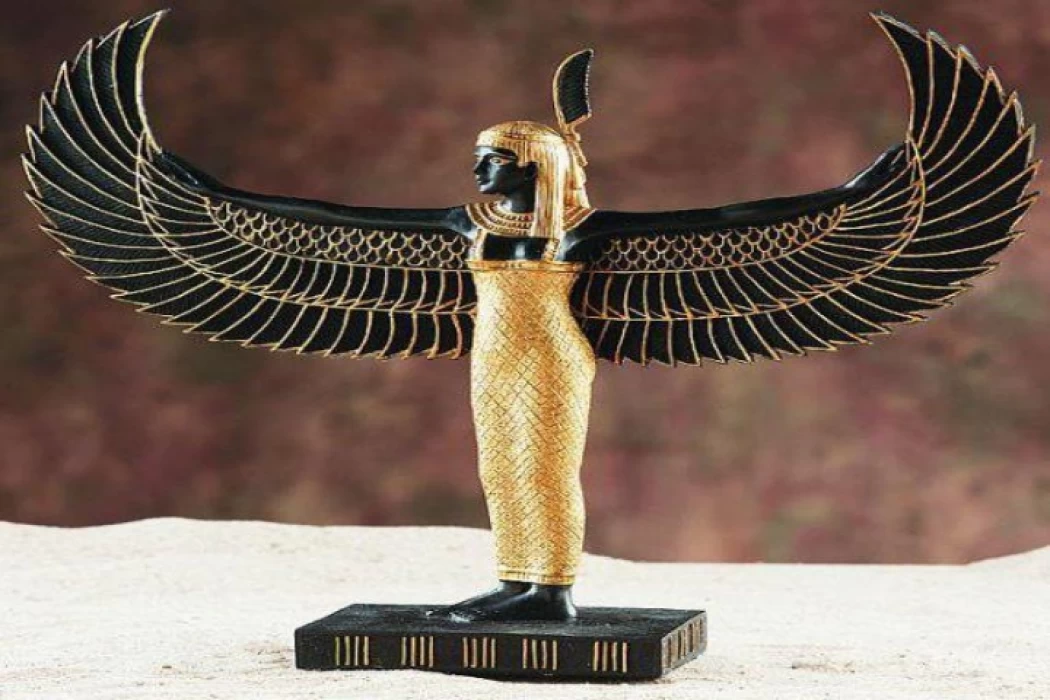
巴斯特(古埃及神)
古埃及的Ma'at女神
女神Ma'at根据古埃及宗教是真理和正义的女神,Ma'at是神和妻子的女儿,以女性的形式代表ma'at女神,头上有鸵鸟羽毛,手持脚踝,意思是生命钥匙,另一只手
在古埃及人的阴间,死者的心脏被放置在一边的鳞片上,另一边是女神Maat的羽毛。 如果受骗者的心倾斜,他就会进入他们信仰中的天堂,但如果羽毛膨胀,他就会进入地狱,这是古埃及信仰所代表的一种假想的掠夺性怪物,名叫Amamut,它的头是鳄鱼的头,身体是狮子的身体,背部是河马的身体。 在黑社会法院由42名法官组成,埃及地区的数量,由奥西里斯领导。
古埃及人在审判日的概念是,阿努比斯会陪死者到法庭上,法官会开始质疑受骗者在这个世界上的行为,以及他是遵循Maat(正确的道路)还是他是罪人之一。 而被欺骗者开始为自己辩护,并说:我没有杀死任何人,我没有揭露一个人,我没有抱怨一个工人与他的老板,我没有偷。 我喂养穷人,给赤身裸体的人穿衣服,帮助人们,给口渴的人喝水。 然后法官开始问他关于他对神的认识,所以他不得不提到神的名字,并提防忘记其中一个。
(Maat)祭品是国王热衷于在寺庙中描述的最重要和最重要的祭品之一,因为它的重要性和重要性。 "Maat"的牺牲证实了国王在地球上实现秩序(Maat)和满足众神的使命。 [4]
"Maat"的概念是一切事物的确切标准体系,它代表了世界的基础,以及与造物主神的目的相对应的一切。 因此,人类必须保存和批准它们,并在"Maat"和系统暴露于任何缺陷或紊乱时将其恢复到适当的状态。 由于埃及人认为maat是整个世界赖以生存的本质和物质元素,是神的力量,是人类中生者和死者的力量,所以"棺材文本"提到神活着(Maat),神在地球上批准了"Maat",而它的批准是在土地上的,是国王的责任,他在人类中代表神,并且像它一样生活(Maat)。
"Maat"的祭品以强烈的象征形式概括了所有对神的崇拜和牺牲,以及寺庙日常服务的所有仪式,以及所提供的祭品。 因此,埃及神庙在各种铭文,宗教场景以及祭品和仪式的场景中几乎没有"Maat"牺牲的场景。
国王有必要承认地球上的"Maat",这体现在国王向众神献上"Maat"作为建立秩序和正义的隐喻,以及诸神想要的任何东西。 国王曾经每天把它呈现给众神,作为他在(Maat)的神圣办公室中代表他们的有形证据。
"Maat的牺牲"表示国王的使命是实现"maat",意思是这里的牺牲是一个隐喻或象征性的表达,以完成国王负责的任务。 虽然许多文本都表明神和国王在道德意义上比在牺牲意义上更重振"Maat",并且神和国王只以"Maat"作为所说的真理和所建立的正义为食。
马特的祭品出现在中国,尽管此后直到图特莫斯三世国王统治时期才出现。这一幕("马特"的祭品)被记录在大多数埃及寺庙墙壁的铭文中,国王站在神面前,并在他手中或在一艘船上向他展示"马特"的象征。 而"Maat"的牺牲将以女神"Maat"的小雕像的形式,真理,正义的女神和紧绷的宇宙秩序坐在她头上的"Maat"羽毛,在她的手中是生命的标志。 在极少数情况下,我们发现只有"Maat"羽毛的呈现,这是在"Seboua"国王"拉美西斯第二"的寺庙中。
在出现"Maat"牺牲场景的寺庙中:Karnak的"Amun-Ra"寺庙(在国王"Thutmose III"统治时期的一些场景中,在一些神灵面前);和"Karnak"的"Aton"寺庙;和Abydos的"Seti The First"寺庙和"Luxor"寺庙。 通常,碑文伴随着祭品的形式,其中包括短语:"Hnk mAat n nb MAat"(将Maat献给Maat的主)。 通常,(Maat祭品)被呈现给男性神,而不是女性。 在被描述接受牺牲的神的最前沿:(Amun;Amun-Ra;Hor-Akhati;Amun-Ra Ka-Mutaf;Amun Min;Ra-Hor Akhti;Ptah;Khonsu;Shu;Ozir;Set;Atum;Montu;Khnum;Sobek;Hathor,Iza,Min)。
Ma`at Goddess in Ancient Egypt
Goddess Ma`at according to ancient Egyptian religion is a goddess of truth and justice, Ma`at is the daughter of Re god and wife to Thout god of knowledge Ma`at goddess represented in women form with ostrich feather above her head and holding the Ankh which means the life key and the other hand holding the mace
In the underworld of the ancient Egyptians, the heart of the dead were placed on the scales on one side and the feather of the goddess Maat on the other side. If the deceased’s heart tilted, he would enter Paradise in their beliefs, but if the feather swelled, he would enter Hell, which was represented by ancient Egyptian beliefs in the form of an imaginary predatory monster named Amamut, whose head is the head of a crocodile and his body is the body of a lion and its back is the body of a hippo. The court in the underworld consisted of 42 judges, the number of regions of Egypt, headed by Osiris.
The 42 Laws of Maat: Ancient Egyptian Society's Ethical Underpinnings The fundamental tenets of justice and morality in ancient Egypt were established by the 42 Laws of Maat.
The conception of the ancient Egyptians on Judgment Day was that Anubis would accompany the dead to the courtroom, and judges would begin to question the deceased about his actions in this world, and whether he was following the Maat (the right path) or was he among the sinners. And the deceased begins to defend himself and says: I did not kill anyone, I did not expose a person, and I did not complain about a worker with his boss, and I did not steal. I was feeding the poor, and I was given clothes to the naked, and I helped people, and I used to give the thirsty water. Then the judges began to ask him about his knowledge of the gods, so he had to mention the gods by their names and beware of forgetting one of them.
To the pharaohs, Ma'at was represented as a goddess with an ostrich feather on her head, a symbol of justice. The goddess held the key of life, Menkh, in one hand and a scepter in the other, symbolizing balance. She was credited with controlling the seasons and the movements of the planets and stars.
The Cult of Maat
While the cult of Maat was more than limited, the respect she commanded was, however, boundless. For maat (justice) was always a cornerstone of social balance. Respect among humankind, in particular, ensured a measure of salvation. A salvation that Maat would appreciate during the final judgment rendered by Osiris. "To speak according to Maat" meant to speak the truth. At the Last Judgment, the heart spoke according to Maat and could not lie. Upon death, no deceased could avoid the trial of the Last Judgment.
There, the weight of good and evil accumulated in each person's heart was calculated. Thus, the deceased who had lived with justice and kindness would be assured of having their heart compared to Maat, to their advantage. It was during psychostasis (the "weighing of the soul") that everything concerning their future in the afterlife was decided. Maat as a principle was created to meet the complex needs of the emerging Egyptian state, which embraced diverse peoples with conflicting interests. The development of such rules sought to avoid chaos, and Maat became the basis of Egyptian legislation.
The concept of "Maat" was the exact standard system for everything, which represents the basis of the world, and everything that corresponds to the purposes of the Creator deity. Hence, it is imperative for humans to preserve and approve them, and to restore "Maat" and the system to its proper condition if it is exposed to any defect or disorder.
And since the Egyptian view of the maat as the essence and material element upon which the whole world lives, and as a power for gods and for the living and the dead among humans, the "Coffins Texts" mentioned that gods live on (Maat), and the gods approved "Maat" on earth, and its approval was on The land is the responsibility of the king, who represents the gods among men, and lives like it on (Maat).















